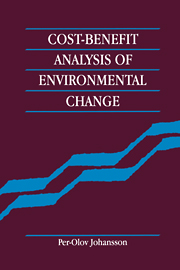Book contents
- Frontmatter
- Contents
- List of figures
- Preface
- 1 Introduction
- 2 Some basic concepts
- 3 Consumer surplus measures
- 4 Valuing public goods: practical methodologies
- 5 General equilibrium cost-benefit rules
- 6 Cost-benefit rules, national income accounts and sustainable development
- 7 Valuation and aggregation: intragenerational and intergenerational issues
- 8 Cost-benefit rules in a risky world
- 9 Valuing changes in access conditions, health risks and information
- 10 Empirical applications
- 11 Policy instruments and international environmental problems
- Notes
- References
- Index
2 - Some basic concepts
Published online by Cambridge University Press: 15 January 2010
- Frontmatter
- Contents
- List of figures
- Preface
- 1 Introduction
- 2 Some basic concepts
- 3 Consumer surplus measures
- 4 Valuing public goods: practical methodologies
- 5 General equilibrium cost-benefit rules
- 6 Cost-benefit rules, national income accounts and sustainable development
- 7 Valuation and aggregation: intragenerational and intergenerational issues
- 8 Cost-benefit rules in a risky world
- 9 Valuing changes in access conditions, health risks and information
- 10 Empirical applications
- 11 Policy instruments and international environmental problems
- Notes
- References
- Index
Summary
This chapter can be viewed as a quick refresher course in microeconomics and welfare economics. The chapter presents some of the tools, such as indirect utility functions, profit functions, definitions of a general equilibrium, Pareto optimality and the social welfare function, that will be used throughout this book. Of necessity, the presentation must be only an outline. The reader interested in detailed investigations is referred to some standard book in microeconomics, such as Kreps (1990) or Varian (1992).
The chapter is structured as follows. Section 2.1 is devoted to the utility maximization problem for a household, while section 2.2 takes a look at the profit maximization problem for a firm. Equilibrium in markets and the meaning of the Pareto-efficiency of a competitive equilibrium are considered in section 2.3. Public goods are introduced in section 2.4, where we derive the condition for the optimal provision of a public good. Sections 2.5 and 2.6 introduce the concept of a social welfare function. The chapter ends with a few comments on the relationship between the social welfare function and social cost-benefit analysis.
Households
Let us consider a household consuming n different private commodities xi, where i = 1, …, n. These can be bought in non-negative quantities at given, fixed, strictly positive prices pi. The household supplies κ different kinds of labour denoted Lj for j = 1, …, κ, treating wage rates, denoted wj, as fixed.
Information
- Type
- Chapter
- Information
- Cost-Benefit Analysis of Environmental Change , pp. 7 - 23Publisher: Cambridge University PressPrint publication year: 1993
